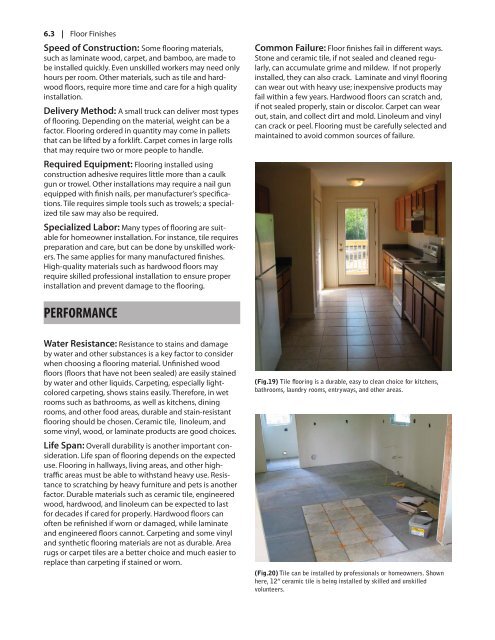Alternative Construction Research Guide - GCCDS
Alternative Construction Research Guide - GCCDS
Alternative Construction Research Guide - GCCDS
You also want an ePaper? Increase the reach of your titles
YUMPU automatically turns print PDFs into web optimized ePapers that Google loves.
6.3 | Floor FinishesSpeed of <strong>Construction</strong>: Some flooring materials,such as laminate wood, carpet, and bamboo, are made tobe installed quickly. Even unskilled workers may need onlyhours per room. Other materials, such as tile and hardwoodfloors, require more time and care for a high qualityinstallation.Delivery Method: A small truck can deliver most typesof flooring. Depending on the material, weight can be afactor. Flooring ordered in quantity may come in palletsthat can be lifted by a forklift. Carpet comes in large rollsthat may require two or more people to handle.Required Equipment: Flooring installed usingconstruction adhesive requires little more than a caulkgun or trowel. Other installations may require a nail gunequipped with finish nails, per manufacturer’s specifications.Tile requires simple tools such as trowels; a specializedtile saw may also be required.Specialized Labor: Many types of flooring are suitablefor homeowner installation. For instance, tile requirespreparation and care, but can be done by unskilled workers.The same applies for many manufactured finishes.High-quality materials such as hardwood floors mayrequire skilled professional installation to ensure properinstallation and prevent damage to the flooring.Common Failure: Floor finishes fail in different ways.Stone and ceramic tile, if not sealed and cleaned regularly,can accumulate grime and mildew. If not properlyinstalled, they can also crack. Laminate and vinyl flooringcan wear out with heavy use; inexpensive products mayfail within a few years. Hardwood floors can scratch and,if not sealed properly, stain or discolor. Carpet can wearout, stain, and collect dirt and mold. Linoleum and vinylcan crack or peel. Flooring must be carefully selected andmaintained to avoid common sources of failure.PERFORMANCEWater Resistance: Resistance to stains and damageby water and other substances is a key factor to considerwhen choosing a flooring material. Unfinished woodfloors (floors that have not been sealed) are easily stainedby water and other liquids. Carpeting, especially lightcoloredcarpeting, shows stains easily. Therefore, in wetrooms such as bathrooms, as well as kitchens, diningrooms, and other food areas, durable and stain-resistantflooring should be chosen. Ceramic tile, linoleum, andsome vinyl, wood, or laminate products are good choices.Life Span: Overall durability is another important consideration.Life span of flooring depends on the expecteduse. Flooring in hallways, living areas, and other hightrafficareas must be able to withstand heavy use. Resistanceto scratching by heavy furniture and pets is anotherfactor. Durable materials such as ceramic tile, engineeredwood, hardwood, and linoleum can be expected to lastfor decades if cared for properly. Hardwood floors canoften be refinished if worn or damaged, while laminateand engineered floors cannot. Carpeting and some vinyland synthetic flooring materials are not as durable. Arearugs or carpet tiles are a better choice and much easier toreplace than carpeting if stained or worn.(Fig.19) Tile flooring is a durable, easy to clean choice for kitchens,bathrooms, laundry rooms, entryways, and other areas.(Fig.20) Tile can be installed by professionals or homeowners. Shownhere, 12” ceramic tile is being installed by skilled and unskilledvolunteers.
















